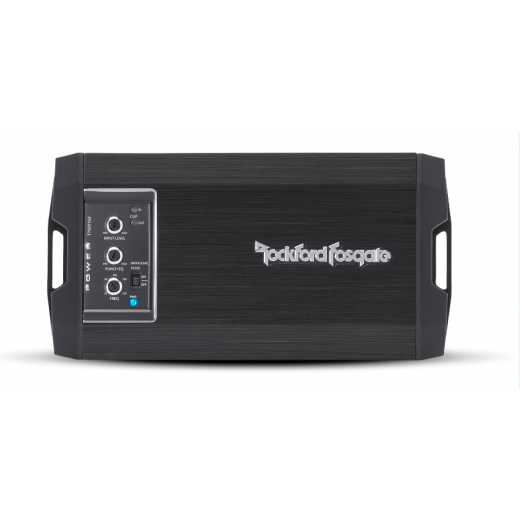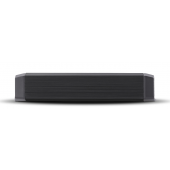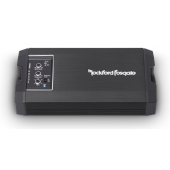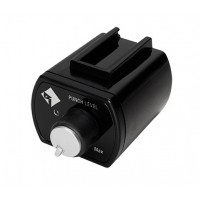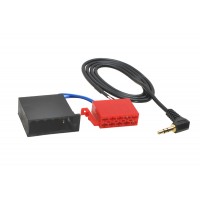Amplifier Rockford Fosgate POWER T750x1bd
More about the product
- Use our consulting room
- You can return the goods to us within 14 days
- Try the product at our store
Amplifier Rockford Fosgate POWER T750x1bd
The Power T750X1 BD is a 750-watt mono ultra-compact amplifier built on Rockford Fosgate's patented Class BD technology. Thanks to the design of this amplifier, its power requirements are very low - it combines the efficient technologies of class D amplifiers with the topology of class B amplifiers. For maximum flexibility when integrating into your vehicle, this model achieves the possibility of modifying the wiring harness with Molex connectivity, which includes both RCA signal, so the speaker level signal. In addition, the input differential circuit eliminates signal noise caused by the input to the amplifier. If you decide to use the input signals of the speaker levels, you will surely be pleased that the amplifier has an automatic switching function, and in addition, it can convert the input from the REMOTE terminal to an output, so it is possible to switch other amplifiers through it. Thanks to this feature, it is possible to eliminate the need to install a power cable from the vehicle to the amplifier.
All the controls are located on the top of this model and access to them, the built-in frequency crossover, the patented Punch equalization to emphasize the depths and the patented CLEAN technology inputs / outputs is very easy. Thanks to a triple thermal fuse with a double fan, you won't have to deal with high temperatures too often with this model. And if it does, the protective thermal circuit will take care of the amplifier in case of high temperature or short circuit. This model is also compatible with the Punch PLC2, which is a remote level control and is ideal for those types of installations where a compact amplifier is needed to generate a large output power.
Key features of the Rockford Fosgate POWER T750x1bd amplifier
- Amplifier class BD.
- Patented low impedance Constant Power technology.
- Differential inputs with high-level automatic switching function.
- Improved RCA connectors.
- Power / ground 8 AWG terminal, speaker 10 AWG terminal.
- REMOTE output when using high-level inputs.
- Option to use 2013 PLC2.
- CLEAN input/output detection and LED indication.
- Controls located on the top.
- Double cooling.
- Instant temperature sensing with Rollback technology.
- Double extruded heatsink.
- Tested according to CEA-2006 Compliant and CE Compliant.
| Catalog number | T750X1BD |
| Brand | Rockford Fosgate |
| Links | Official web presentation |
| Number of amplifier channelsAmplifiers are divided into: - Monoblocks - 2-channel - 3-channel - 4-channel - 5-channel - 6-channel - multi-channel Each channel is used to power one speaker for the coaxial type, or one side if they are component speakers. Monoblock type amplifiers are mainly used for subwoofers. 2-channel are suitable for both subwoofers and, for example, the front pair of speakers in a car. 3-channel is used for front or rear speakers + subwoofer. 4-channel are used for front + rear speakers or 1 pair of speakers + subwoofer. 6 or 5-channel are used for 2 pairs of speakers + subwoofer, most often. Bridging means connecting the amplifier to a bridge, using the + pole from one channel and the - pole from the other channel. In most cases this is shown as "BRIDGED" on the amplifier. | 1 |
| Energy class of the amplifierAmplifiers are divided into two basic classes: analog and digital . Analog amplifiers (A/B) have higher consumption requirements, but usually have a more natural sound. Digital amplifiers (D) have significantly lower consumption and higher efficiency, but the sound may not be as faithful as with classic analog amplifiers. | BD |
| RMS power into 4 ΩRMS power when loading speakers or subwoofer at 4 Ω. RMS power is the constant power of the amplifier and is one of the most important parameters when choosing an amplifier. | 1 x 500W |
| RMS power into 2 ΩRMS power when loading speakers or subwoofer at 2 Ω. RMS power is the constant power of the amplifier and is one of the most important parameters when choosing an amplifier. | 1 x 750W |
| RMS power into 1 ΩRMS power when the subwoofer is loaded at 1 Ω. RMS power is the constant power of the amplifier and is one of the most important parameters when choosing an amplifier. When connected to 1 Ω, significant heating of the amplifier may occur. | 1 x 750W |
| Low-pass filter (LPF)LPF / LP or "low pass filter" offers the possibility to adjust the amplifier using a potentiometer so that the lower band plays only the frequencies in a certain band that you need. This filter is used to adjust the frequency range for the subwoofer, so that it does not overload or distort the sound. Example: Amplifiers most often have an LPF from 20 to 300 Hz. We recommend setting this potentiometer in the range of 45-80 Hz. | 50 - 250 Hz |
| Frequency rangeThe ability of the amplifier to reproduce the signal from the lowest frequency to the highest = faithfully reproduce the sound in a specific frequency band. Professionally: In the frequency range from 40 to 16,000 Hz, the vast majority of fundamental and overtones (harmonics) of all musical instruments are found. We are interested in the course of the radiated sound pressure in this range of frequencies when the loudspeaker system is supplied with constant power. We call this course the frequency characteristic, which tells us the level of radiated sound pressure in decibels (dB) depending on the frequency. The frequency characteristic of a speaker or speaker system can be expressed most succinctly with a graph. Mostly, however, the frequency characteristic is indicated by indicating the maximum tolerance of the sound pressure in the given frequency range, e.g. 50 to 15,000 Hz -+ 6 dB. Since the frequency characteristics of loudspeakers and systems in general are quite uneven, some manufacturers do not even specify this maximum tolerance of sound pressure in decibels in their catalogs for reasons of prestige. Data impoverished in this way is unfortunately worthless. What is valid is that the manufacturer offers a speaker system with a frequency range of 30 to 20,000 Hz, if he is worried about stating the maximum unevenness of the sound pressure in this range, because he can have a tolerance of, for example, +- 20 dB. The unevenness or undulation of the frequency curve in good speaker systems for high-quality music performance should not exceed +-3 dB in the 80 to 12,000 Hz band and +-6 dB in the 40 to 16,000 Hz band. Greater unevenness already depletes or emphasizes certain tonal areas, which can cause audible or even disturbing distortion. The proportion between fundamental tones and higher harmonics also changes, thereby changing the color of the sound, and individual musical instruments as well as the entire musical image sound unnatural. | 20Hz - 220Hz +/-1dB |
| Input sensitivityIn order for the amplifier to perform its function correctly, it requires an input signal of a certain level, which is different for car radios. It is measured in "Volts" (e.g. 2 V, 4 V, etc.) The higher the value at the output of the pre-amplifier, or car radio, the less demands are placed on the power of the amplifier. However, the amplifier must allow this input sensitivity, and for that reason this value is also given for the amplifier. | 150 mV to 12 V |
| High level inputsThe high-level input on the amplifier allows connection directly to the existing speakers in the car without additional purchase of an external high/low adapter. Important equipment in the case of installing an amplifier on an original car radio. | Yes |
| Automatic on and offThis function allows you to automatically switch on the amplifier. | Yes |
| Socket input terminalsFerrule terminals allow better wiring contact to the amplifier. It is also a more secure form of terminals. If you are tightening the sleeve terminals, we recommend retightening them after 1 day, as the connected cable gradually compresses. | Yes |
| Remote control included in the packageSome models of amplifiers also come with wired remote controls in the package, which on one side plug into the amplifier and on the other side you have a potentiometer that you can place anywhere in the cabin. A common place to place the remote control is under the steering wheel. The advantage is the regulation of power, and therefore volume, depending on driving conditions and the mood of the crew in the car. | No |
| Input for wired remote controlIf the amplifier has a remote control input. | Yes |
| Dimensions of the amplifier | 41 x 107.9 x 211 mm |
